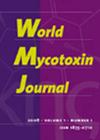玉米青贮真菌毒素对犊牛肠上皮细胞系细胞毒性的实时动力学分析
IF 1.7
4区 医学
Q3 FOOD SCIENCE & TECHNOLOGY
引用次数: 0
摘要
在温带气候条件下,玉米青贮中常见真菌毒素脱氧雪腐镰刀菌烯醇(DON)、雪腐镰刀菌烯醇(NIV)、腐镰刀菌烯醇B (ENN B)、霉酚酸(MPA)、芦quefortine C (ROC)和玉米赤霉烯酮(ZEN)。虽然瘤胃微生物群能够降解一些真菌毒素(如DON),但已知其他真菌毒素主要保持完整(如ROC)。此外,由于瘤胃pH值过低或瘤胃微生物活性降低,霉菌毒素的降解也会受到阻碍。因此,这些真菌毒素可以到达小肠并对肠上皮细胞产生细胞毒性作用。本研究在犊牛小肠上皮细胞系(CIEB)中对这6种真菌毒素及其代谢产物(α-和β-玉米赤霉烯醇,α-和β-ZOL)的细胞毒性进行了实时动力学分析。通过测定细胞凋亡和坏死参数以及细胞融合度来评价霉菌毒素诱导的细胞毒性。Annexin-V绿色和Cytotox红色联合染色检测细胞早期和晚期凋亡及坏死。测试了0.78 ~ 12.5 μM范围内的6种不同浓度。与未暴露于真菌毒素的细胞相比,DON和NIV发挥快速毒性作用,在孵育的头几个小时内DON的毒性大于NIV,而在孵育的16小时内观察到相反的情况。另一方面,MPA和ZEN在孵育数小时内诱导Annexin V绿色阳性细胞增加,并且随着时间的推移毒性更高。仅在检测的最高浓度下,ROC检测到膜联蛋白V绿色和细胞毒素红色阳性细胞的增加。对于ENN B,仅在12 h后观察到Annexin V绿色阳性细胞增加,α-和β-ZOL未表现出细胞毒性作用。因此,霉菌毒素暴露导致严重(DON和NIV)或更有限(ZEN, ROC, MPA和ENN B)的牛肠上皮损伤风险。本文章由计算机程序翻译,如有差异,请以英文原文为准。
Exploratory real-time kinetic analysis of the cytotoxicity induced by maize silage mycotoxins in a calf intestinal epithelial cell line
In a temperate climate, the mycotoxins deoxynivalenol (DON), nivalenol (NIV), enniatin B (ENN B), mycophenolic acid (MPA), roquefortine C (ROC) and zearalenone (ZEN) are often found in maize silage. Although rumen microbiota are able to degrade some mycotoxins (e.g. DON), others are known to stay mainly intact (e.g. ROC). In addition, mycotoxin degradation can be hampered by a low ruminal pH or decrease in rumen microbial activity. Hence, these mycotoxins can reach the small intestine and exert a cytotoxic effect on intestinal epithelial cells. In this study, a real-time kinetic analysis of the cytotoxicity of these six mycotoxins and some of their metabolites (α- and β-zearalenol, α- and β-ZOL) was performed in a calf small intestinal epithelial cell line (CIEB). Confluency as well as the cell death parameters apoptosis and necrosis were determined to evaluate the mycotoxin-induced cytotoxicity. A combination of Annexin-V green and Cytotox red staining was used to determine early and late apoptosis as well as necrosis. Six different concentrations were tested ranging from 0.78 to 12.5 μM. Compared to cells not exposed to mycotoxins, DON and NIV exert a fast toxic effect with DON being more toxic than NIV within the first hours of incubation, whereas the inverse was observed at 16 h of incubation. On the other hand, MPA and ZEN induced increased Annexin V green positive cells within several hours of incubation with higher toxicity over time. Increased Annexin V green and Cytotox red positive cells were seen for ROC only at the highest concentration tested. For ENN B, increased Annexin V green positive cells were observed only after 12 h and α- and β-ZOL did not show cytotoxic effects. Hence, mycotoxin exposure causes either severe (DON and NIV) or more limited (ZEN, ROC, MPA, and ENN B) risk of bovine intestinal epithelial damage.
求助全文
通过发布文献求助,成功后即可免费获取论文全文。
去求助
来源期刊

World Mycotoxin Journal
MYCOLOGY-
CiteScore
4.60
自引率
5.00%
发文量
25
审稿时长
>12 weeks
期刊介绍:
''World Mycotoxin Journal'' is a peer-reviewed scientific journal with only one specific area of focus: the promotion of the science of mycotoxins. The journal contains original research papers and critical reviews in all areas dealing with mycotoxins, together with opinions, a calendar of forthcoming mycotoxin-related events and book reviews. The journal takes a multidisciplinary approach, and it focuses on a broad spectrum of issues, including toxicology, risk assessment, worldwide occurrence, modelling and prediction of toxin formation, genomics, molecular biology for control of mycotoxigenic fungi, pre-and post-harvest prevention and control, sampling, analytical methodology and quality assurance, food technology, economics and regulatory issues. ''World Mycotoxin Journal'' is intended to serve the needs of researchers and professionals from the scientific community and industry, as well as of policy makers and regulators.
 求助内容:
求助内容: 应助结果提醒方式:
应助结果提醒方式:


